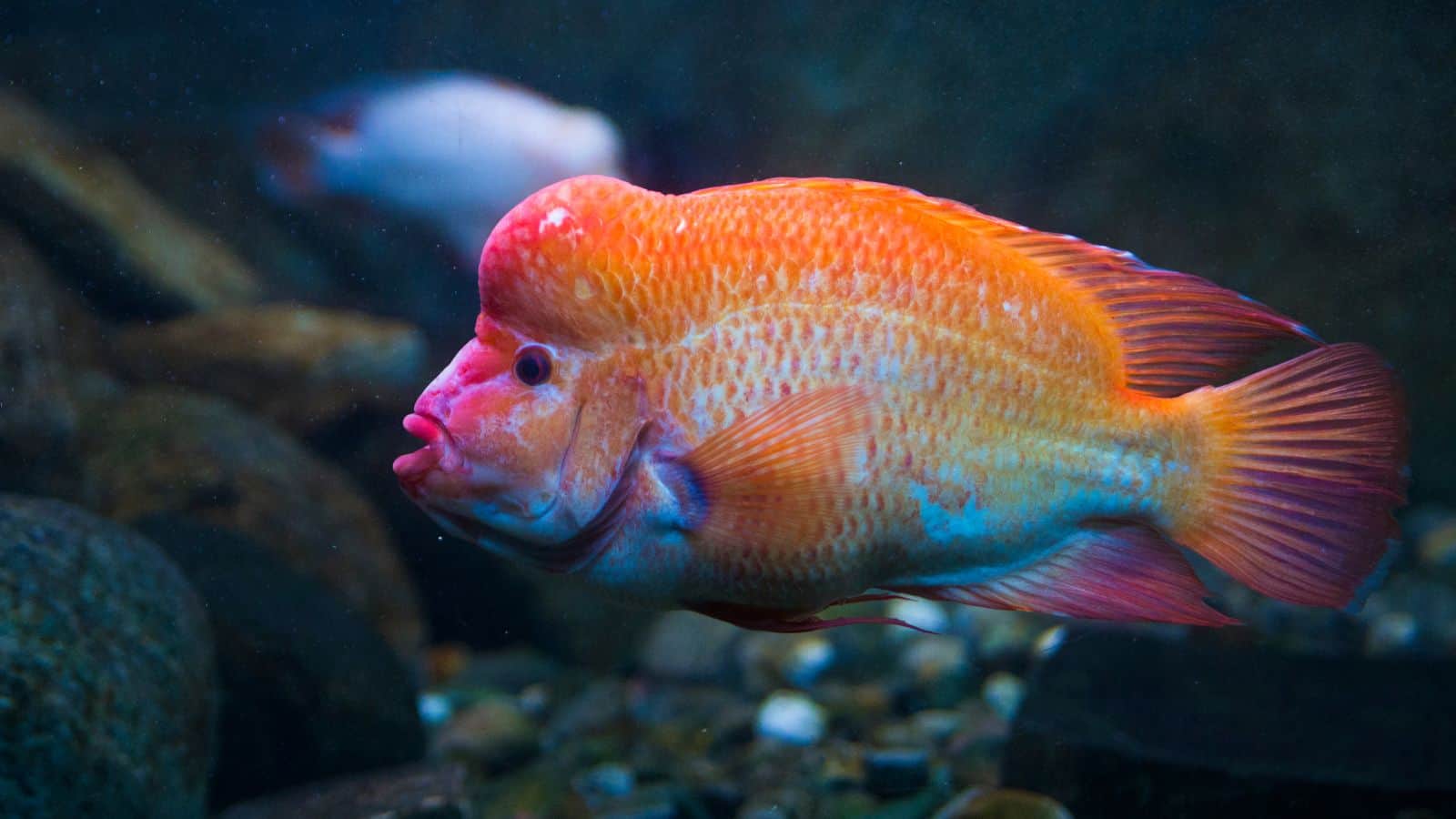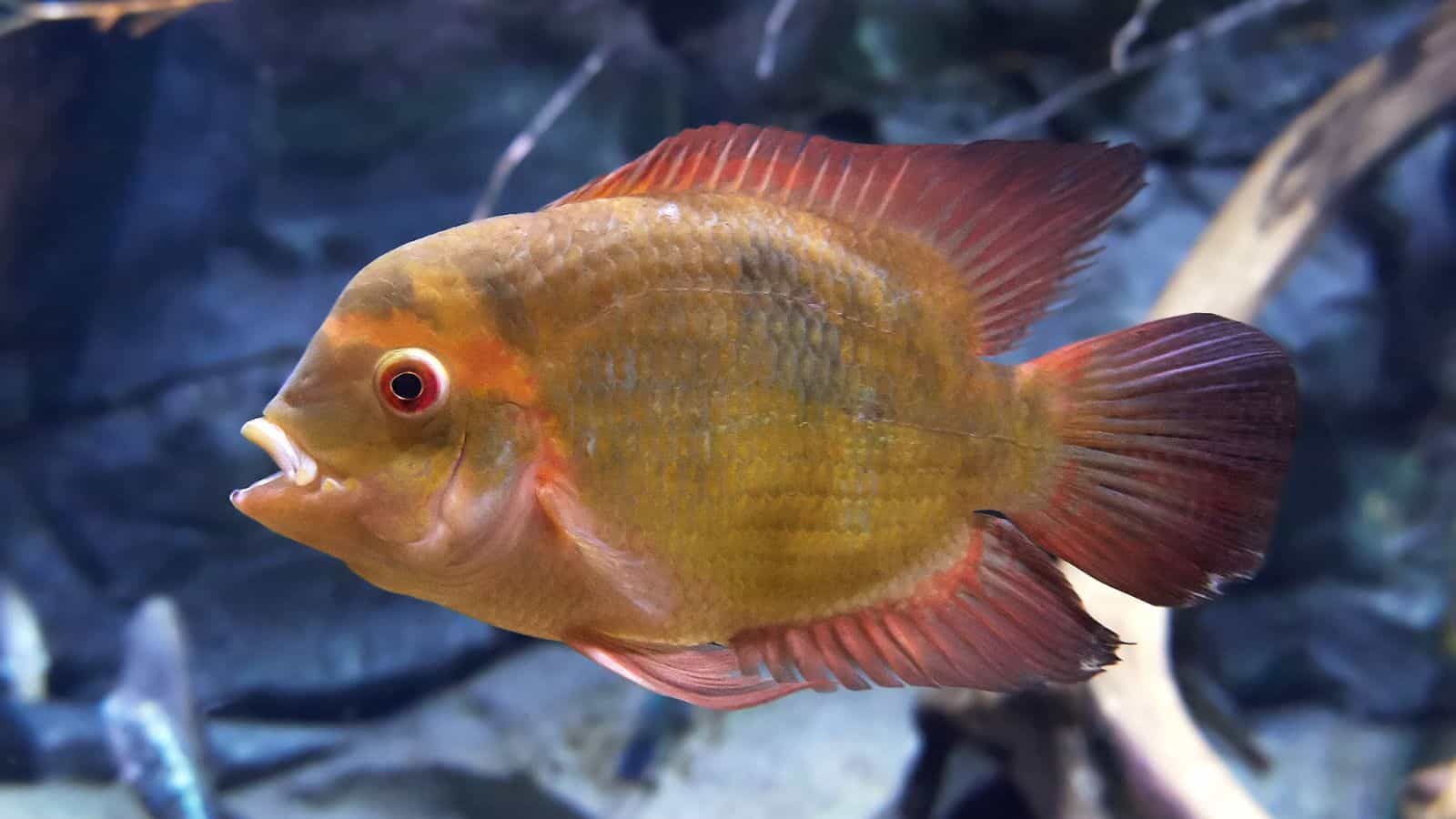If you’re setting up a cichlid tank and you want a specimen with charisma, presence, and attitude, look no further than the Red Devil cichlid!
The fish’s common name gives you a clue to its temperament. These critters can be aggressive toward other fish, so you need to choose tank mates for your Red Devil with care, but on the flip side, these fish can bond with you like a puppy!
Read this guide to learn everything you need to know about the beautiful Red Devil cichlid and its care.
Red Devil Cichlid – At a Glance
| Red Devil Cichlid Info | |
|---|---|
| Scientific Name: | Amphilophus labiatus |
| Common Name (species): | Red Devil Cichlid |
| Family: | Cichlidae |
| Origin: | Central America |
| Diet: | Omnivore |
| Care Level: | Experienced |
| Activity: | High |
| Lifespan: | 10 to 12 years |
| Temperament: | Aggressive |
| Tank Level: | All areas |
| Minimum Tank Size: | 55 gallons for a single fish |
| Temperature Range: | 75 to 79° F (24 to 26° C) |
| Water Hardness: | 6 to 25 dGH |
| pH Range: | 6.5 to 7.5 |
| Filtration/Flow Rate: | Moderate |
| Water type: | Freshwater |
| Breeding: | Open water egg-layer |
| Compatibility: | Aggressive and territorial |
| Plant-safe?: | No |
Origins and Natural Habitat
In the wild environment, Red Devil cichlids are found in Central America’s Managua, Nicaragua, and Xiloa lakes.
The fish prefer calm, open waters and gravitate toward rocky outcrops where they can find lots of safe hiding places and shelter. The water here is dark and murky, and the fish feed on whatever prey they can find living on the substrate, including insect larvae, snails, and smaller fish.
Lifespan
These beautiful fish can live for between 10 and 12 years. It’s worth noting that the fish’s lifespan is usually extended if they are provided with ideal living conditions and a high-quality correct diet.
Size
Red Devils are huge fish, growing to 15 inches when fully mature, so you’ll need a very large tank to house one of these beauties!
The fish can take up to three years to reach their full size, although they can breed when just six inches long.
Male fish are generally slightly larger than females, although they both have the same stocky body shape.
Colors and Patterns
Red Devil cichlids vary widely in color, with wild specimens tending to be darker brown or gray as a form of camouflage. However, ornamental captive specimens come in beautiful shades, from pale yellow to bright orange, red, and even white.
The fish’s anal and dorsal fins sweep backward, ending in a point, and some specimens have contrasting black tips on their tails and fins.
Red Devils have a mouth full of sharp teeth set in strong jaws, making them excellent predators and also potentially damaging to your plants. These striking fish generally have thick, orange lips, although some can be black.
Red Devil cichlids are sometimes mistaken for the Midas cichlid (Amphilophus citrinellus), but the Red Devil has larger lips than the Midas.
Differentiating the Sexes
The most obvious physical difference between male and female Red Devil cichlids is the raised feature or nuchal hump on the male’s forehead. Although the hump is usually only present when the male is in spawning condition in the wild environment, it can be a permanent feature with captive specimens.
Another obvious gender difference is the female’s blunt genital papilla, whereas the male’s is pointed.
Availability and Price
Availability varies, depending on your location and the time of the year. However, since these fish are very popular among hobbyists, you can usually find them in good fish stores and online.
Prices vary, depending on size, color, and the seller’s location, but you can usually pick up a juvenile specimen for between $10 and $30. Mature adult fish and those with especially vibrant coloration and patterns will be more expensive.
Behavior
One reason for the popularity of these vibrantly colored fish is their personality. Red Devil cichlids react to their owners rather like a pet dog would, following them up and down the tank and displaying for attention.
However, the downside to this cichlid species is that they are notoriously aggressive toward other fish in their community and even toward their own kind. So, although you can keep Red Devils with other semi-aggressive fish of a similar size as juveniles, I advise you to keep just one adult specimen on its own unless you have a very large tank to accommodate this territorial species.
Red Devil cichlids are infamous diggers that will uproot or destroy your aquatic plants and overturn any decorations you have resting on the substrate. Even your tank equipment, such as filter boxes and downpipes, isn’t safe from the fish’s attention and can easily become damaged if left unprotected.
Are Red Devil Cichlids Suitable for Beginners?
Bearing in mind the fish’s aggressive, territorial, and destructive nature, we don’t recommend Red Devil cichlids for beginner aquarists. In addition, these fish grow to a very large size and need a much bigger aquarium than most novice hobbyists want to keep.
Red Devil Cichlid Care Guide
In this part of our guide, we explain how to care for this charismatic, feisty fish.
Tank Size
Given the Red Devil cichlid’s behavioral traits and adult size, you will need a large aquarium of at least 55 gallons for one full-grown fish.
If you want to try keeping a pair of these fish, you should plan on a tank of at least 125 gallons, and if you want to introduce other species to create a community, the minimum tank size you should consider is 200 gallons or ideally, more.
As with most aggressive, territorial fish species, you should provide them with plenty of room to swim and allow shy fish to escape and hide if needed. In addition, larger tanks give the Red Devil cichlids the space they need to establish and defend a territory in a multi-species setup.
Tank Shape
When it comes to tank shape, these large fish need plenty of open swimming space to replicate what they have in their natural environment. So, we recommend a long, rectangular tank rather than a tall, deep one.
Water Parameters
Red Devil cichlids are sensitive to water quality, so you need to keep your tank well-maintained with stable water parameters that are well within the tolerance levels of all the fish species you keep.
To keep the water clean and healthy for the fish, carry out weekly partial water changes of around 30%, taking care to remove organic debris, such as fish waste, leftover food, and general detritus from the substrate, using an aquarium vacuum cleaner.
Red Devils are tropical fish that need a water temperature between 75 and 79°F (24 to 26°C), with a water hardness of between 6 and 25 dGH and a pH in the range of 6.5 and 7.5.
Lighting
Red Devil cichlids don’t require any special lighting, and a regular aquarium LED lighting unit is fine. Since you won’t be using living plants in your tank, you can keep the lights on for around 8 hours daily, switching them off at night to create the day/night environment that your fish needs to thrive and remain stress-free.
Filtration
Red Devils appreciate a well-oxygenated environment, so ensure you run an air stone, bubbler, or something similar.
You will need a powerful filtration system that produces a moderate current. a dual filtration system works very well, using a canister filter or sump.
As mentioned earlier, these fish can be very destructive, and you will need to protect your tank equipment by using external devices if possible or protecting them behind stable objects in the tank that the fish cannot easily get to.
Decoration
As previously mentioned, Red devil Cichlids love to dig, so choose a sandy substrate to prevent your fish from getting injured. I prefer to use a dark-colored substrate that works well to show off the fish’s bright colors.
Rocks and driftwood, as well as a few caves and rocky overhangs, can create handy hiding spots for smaller tank mates, but you need to make sure all your decorations are embedded securely in the substrate or even fixed to the tank bottom using aquarium-safe adhesive. If you don’t securely anchor your decor, the fish will almost certainly demolish your carefully designed aquascape!
It’s a good idea to place most of your decor items around the perimeter of the aquarium so that the fish can enjoy plenty of swimming space.
What About Plants?
Unfortunately, using live plants in an aquarium with this fish species is usually a recipe for disaster since the fish will either rip up the plants, uproot them, or eat them.
Nutrition and Feeding
Red Devil cichlids are omnivores that will eat pretty much everything.
Feed your fish a well-balanced diet that includes frozen and fresh foods in addition to commercially produced cichlid pellets or flakes. Red Devils enjoy live foods like bloodworms, earthworms, krill, and crickets. However, live food often comes with unwanted extras, such as bacteria and parasites that you don’t want in your tank, so you must find a reliable supplier.
Remember, these omnivores need plant matter in their diet and meaty proteins, so offer your fish lettuce, spirulina flakes, shelled peas, and broccoli for a complete menu.
How Much To Feed Red Devil Cichlids
Offer your fish what they will eat in a few minutes, and feed them several times every day.
Tank Mates
By now, you may be thinking that if you want to keep a Red Devil cichlid, you will have to keep one single specimen, and unfortunately, that is true. When the species is young, you can usually keep them with other fish of a similar temperament, but they are best kept singly when fully mature.
Younger Red Devils have been kept successfully with the following fish species:
Health and Diseases
One very good quality that these fish possess is that they are extremely hardy and not prone to any particular disease or health condition. That said, a few common fish diseases can affect these cichlids, usually when water quality and diet are poor.
Ich
Ich or White Spot Disease, can often affect new arrivals to the tank, usually due to the stress of transport and a new environment. However, you can treat the disease quite easily with over-the-counter medication and by correcting the water conditions in your tank.
Hole-In-The-Head Disease
Hole-in-the-head disease is also caused by poor water conditions and an unsuitable diet. This condition often affects cichlids of all species and manifests as pits or holes on the fish’s head, face, or body.
Parasites
Red Devil cichlids can also be prone to attack by parasites, including flukes, worms, and protozoa. Again, in a poorly maintained aquarium with dirty water, bacteria and fungus can cause infections.
Disease Prevention
You can do much to prevent disease outbreaks in your tank by maintaining clean water, providing your fish with a correct, high-quality diet, and placing any new fish in a quarantine tank for at least two weeks before introducing them to your main display aquarium.
Breeding
It’s relatively easy to breed Red Devil cichlids in a home tank.
The fish form breeding pairs and, as open spawners, will lay their eggs in open water. All the fish needs in the tank are a flat or slightly inclined surface area and a water temperature of around 77°F.
Female Red Devils lay from 600 to 700 clear or yellow-orange colored eggs on flat rocks or slightly inclined surfaces. The eggs hatch within three to four days, and the fry will be protected by their parents, with the male excavating a shallow depression and moving the fry into it for safety.
After five to seven days, the fry will be free-swimming, and you can feed them Artemia nauplii until they are large enough to cope with larger foods.
Final Thoughts
Red Devil cichlids are extremely hardy, beautiful fish that make excellent pets for someone with experience in keeping aggressive, territorial species. Although you can keep these fish with tank mates and their own kind as juveniles, Red Devils can become extremely aggressive and territorial as they mature, so ideally, you should keep one specimen or possibly a breeding pair.
You will need a large aquarium of at least 55 gallons for one of these fish and a tank of up to 200 gallons if you want to keep a breeding pair of Red Devil cichlids together with some suitable tank mates.
If you’re content to keep a single Red Devil, you’ll enjoy the company of a charismatic, quirky character who will even interact with you every time you pass by his tank.



